Elementary, My Dear Metal Men
It’s 1962. You are Irwin Donenfeld, executive vice president for DC Comics, the 800-pound gorilla of superhero comics. You are riding high on the Silver Age of comics, having revived superhero comics from their near-death experience at the hands of Fredric Wertham, the New York District Attorney, and Congress itself. A dozen new versions of 1940s legends have poured from your offices since 1956 along with brand-new successes. The secret? Showcase, a comic invented purely to give tryouts to comic concepts and get the fans, the readers, the buyers to write in insisting that one or another of them be given their own titles. The Barry Allen Flash emerged from Showcase #4, The Challengers of the Unknown in #6, Lois Lane in #8, Green Lantern in #22, Aquaman in #30, the Atom in #34.
Now you’re a victim of your own success. The Atom, after also appearing in Showcases #35 and #36, is a smash. He’s getting his own title. But he was supposed to appear in Showcase #37, March-April 1962, as well, which is due at the printer in two weeks, and you don’t want to use him again. What do you do?
You turn to Robert Kanigher, the “fastest man alive” as one tribute article termed him. He claimed he wrote 100 pages of comics a week, always starting with an empty page, meaning not even an idea. He tells this story on his first comics job in the 1940s:
I answered an ad (things were very bad at our house, economically) and walked into an office about a mile long. At the end of it is a desk about the size of a football field. Behind it is a bald head.
The bald head tells me “Tell me a story.”
Without breaking stride, I said “A skeleton is driving an open convertible from Times Square (not someone in a costume, but a real skeleton) and people are running in sheer panic.”
He said “I like a man who thinks on his feet.” C.W. Scott, my editor. That was it.
Donenfeld asked Kanigher if he had any ideas. Of course he did. “Metal Men. I’d write them with human characteristics but, nevertheless, keeping their metallic characteristics.”
Where did he come up with such an idea? No one knows at this point, but you can read a lot about the Metal Men without anyone mentioning All Star Comics #26, Fall 1945. Gardner Fox’s story pitted the Justice Society of America (the 1940s predecessor to the Justice League) against “The Mystery of the Metal Menace.”
The big tin can on the cover is one of a spaceship full of “metal men” from Jupiter. When they eat metals they take on their characteristics. In those days each member of the Justice Society fought in separate chapters so Fox invented Silver, Iron, Magnesium, Copper, and Gold groups of metal men who the heroes defeat by using their metallic properties against them. Hmm. Not only was Fox was still around in the early 60s, he scripted a number of Showcase issues. Could he have reminisced in Kanigher’s presence? Fox had in 1960 written the first new Justice League adventure, with the heroes facing the menace of Starro the Conqueror, who, no matter what else the name might evoke, was a gigantic flying starfish which was defeated by coating it with quicklime.
I’m not accusing Kanigher of base imitation. His villain is totally different. Its a gigantic flying manta ray. The story begins millions of years ago when a “radio-active bombardment” kills off the dinosaurs. All except one, who is trapped in a glacier until 1962 when melting arctic ice – apparently the first symptom of global warming – frees it.
I produced it in ten days, from a single sentence. With editors, assistant editors, conversations, tapes — they can’t put out a book in two months. I, Ross Andru, Mike Esposito…
Anyway, I did the twenty-three pages on Saturday. My wife typed it up on Sunday.
I don’t think of myself as a carper (I’ve heard all the puns, thank you) if I point out that a gigantic flying manta ray is not a dinosaur, dammit. Was Ross Andru hallucinating on his pencil shavings or was the shape written into the script? As with the metal men from Jupiter, nobody seems to have ever noticed or cared if they did. Me, I get a tic over my left eye. I can’t rationally justify stumbling over minor points like that when I merely nod approvingly when Kanigher reveals that the radio-active bombardment worked exactly like all radioactivity in 1960s comics and bestowed the manta ray with superpowers like heat rays and freeze beams. (Is it another insult to Kanigher to point out that the Fantastic Four had debuted just a few months earlier replete with superpowers granted by a cosmic ray bombardment? Given that group’s resemblance to the Challengers of the Unknown, drawn by Jack Kirby, probably not. The tiny world of comic writers inhabited an inbred universe.)
As every comics reader, even the preteens, surely understood, ordinary weapons don’t work against superpowered dinosaur slash manta rays. The military turns to “the man who makes science fiction ideas practical – Dr. Will Magnus.” [bolding in original]
Dr. Will just happens to have on hand a bevy of living robots, Gold, Iron, Lead, Mercury, Tin, and Platinum, each made out of one element. Totally out of one element. All the nuts and bolts and wiring and the nuclear-powered microscopic activator. The man’s a genius. He, like DC, is a victim of his success. He’s made the robots too good. Each has a human-like personality that befits its element and Platinum, cast in an exquisitely beautiful female form, is breathlessly in love with him. Yet she’s as eager as the others to do battle with the baddies, over his fatuous objections.
Then things get weird. (Then?) The Metal Men work together and use all their elemental might against the manta ray. And fail. Over and over again.
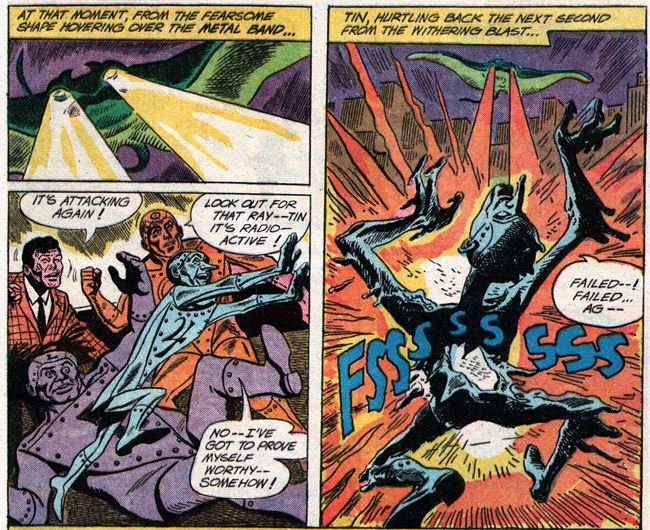 |
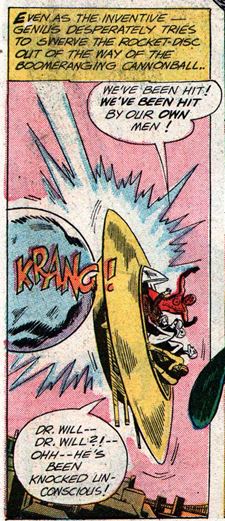 |
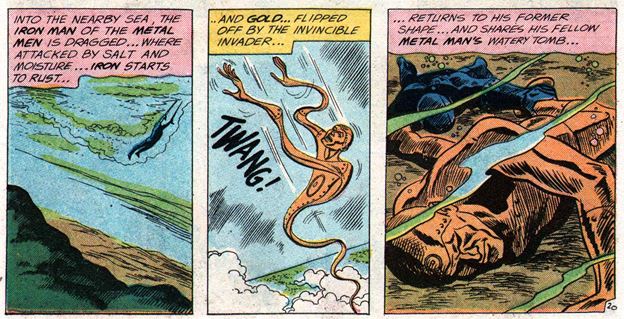 |
Eventually Lead, who like the others can alter his body at will and reshape himself except when the plot says he can’t, spreads himself around the manta ray, i.e. coating the marine animal. I imply nothing. As everyone who ever read a Superman comic of the era knew, lead stops all radioactivity cold. The creature plunges into “a huge undersea trench,” conveniently located a block or two from downtown, taking all the remaining Metal Men with it.
Well, Donenfeld wanted a one-shot fill-in, didn’t he?
Nobody told the readers. The issue drew an extraordinary 7000 letters demanding, pleading, imploring the return of the Metal Men, as shown in the letter column for Showcase #39.
Today superheroes die and come back so regularly that their friends don’t even bother to attend their funerals. In the early 1960s resurrecting a dead hero was unheard of. Kanigher, deliberately or inadvertently, neatly sidestepped any controversy. Robots are built. If one can be built, so can its replacement. It must have been a tight thing despite the bimonthly schedule, but evidently a sufficient amount of fave feedback led to the Metal Men returning in the very next issue, Showcase #38, May-June 1962.
Yet something is off. The robots are, well, robotic.
And up against a gigantic nuclear robot foe, they are not merely inadequate but inept.
Great Ceasar’s Ghost! Do robots have to have human personalities to function properly? How could this batch be so different? Like a good scientist, Dr. Magnus goes through his notes to for what he did differently the first time. Fortunately, there’s a sound scientific explanation at the base of it all.
Sadly for physics students everywhere, readers are never told exactly how Dr. Magnus reproduces the aurora borealis activity. He does, for the new/old Metal Men are their bickering, narcissistic, and neurotic selves once again. They can perform all their old tricks – almost literally copied from issue to issue – and need to when up against a far more interesting robot opponent. Von Vroom, an ex-Nazi scientist who fled to an evil foreign country, the USSR in all but name, has a snazzy giant terror robot wielding a variety of deadly rays. Better yet, every time the Metal Men knock it down, it sheds its outer shell and reveals a smaller unscathed ray-shooting variant. Kanigher anticipates the 1964 World’s Fair as a suitable setting for the innocent-bystander-strewn showdown, an echo of the many comic stories featuring robots at the 1939-40 New York World’s Fair. The Metal Men emerge as the heroes but a close read of the story reveals that Von Vroom defeats himself after the Metal Men are knocked out of action. The tweens the story aimed at didn’t seem to catch the nuance: the letter column in Showcase #40 was a thesaurus of superlatives.
The next two issues of Showcase were mostly perfunctory, a Metal Man comic a foregone conclusion although scheduling realities meant that it didn’t appear until March 1963. Kanigher dug deep into his one-page chemistry cheat sheet for a worthy foe. What is the logical antipode to elements? Compounds! And so Chemo was born.
Chemo is an insidious foe, armed with the power to … tarnish!
What’s truly amazing about that power is that gold can’t tarnish. And yet Chemo makes it happen!
Weirdly (the word keeps reoccurring, like my tic), even though Chemo was in both issues neither cover featured him (it?). Even more weirdly, both issues end with the Metal Men valiantly striving and failing and Doc Magnus coming up with the winning solution. Maybe a point about the need for the creativity of the human brain being more important than mechanical might was being made. Or maybe Kanigher kept writing himself into corners.
Chemo and a zillion robot foes would be the main menaces in the Metal Man comics, as their titles screamed: “Rain of the Missile Men!,” “Robots of Terror!,” “Menace of the Mammoth Robots!,” “The Robot Juggernaut!,” “Raid of the Skyscraper Robot!,” “The Headless Robots!,” “The Revenge of the Rebel Robot,” “Robots for Sale,” and “Birthday Cake for a Cannibal Robot!” (That last is psychedelically weird, even if, maybe especially if, the cake is made of robots.) Battered but never bruised, the Metal Men soared until the end of the 1960s with periodic revivals after. The last panel of the last Showcase to feature them concisely sum their story.
Steve Carper writes for The Digest Enthusiast; his story “Pity the Poor Dybbuk” appeared in Black Gate 2. His website is flyingcarsandfoodpills.com. His last article for us was Canco Charlie.
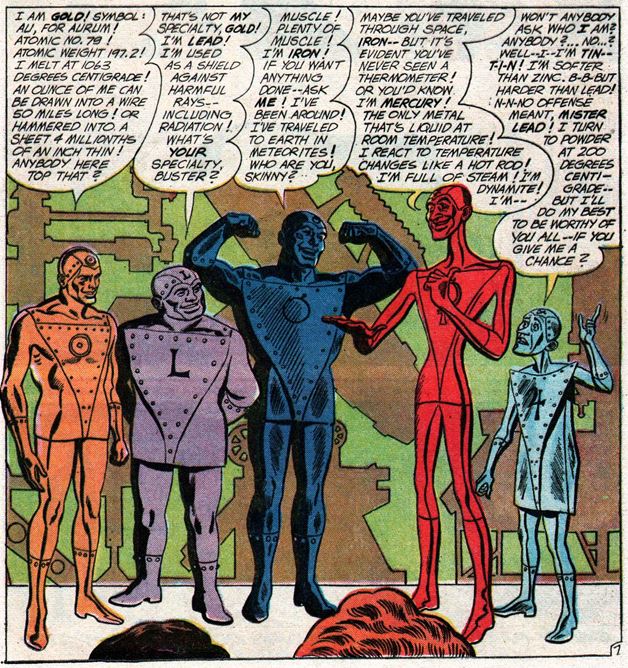
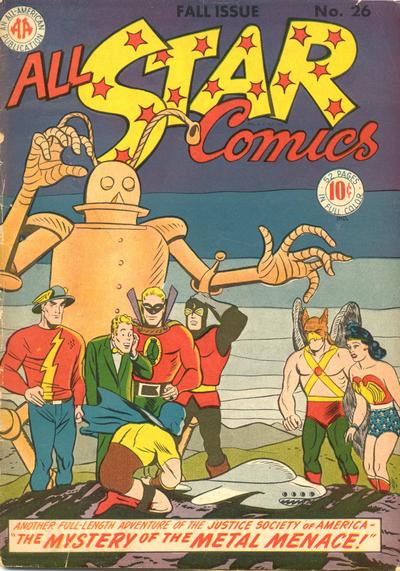
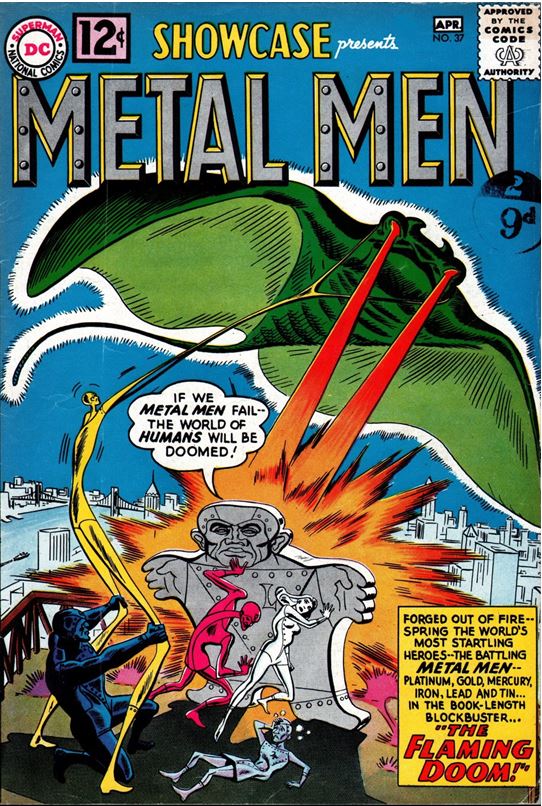
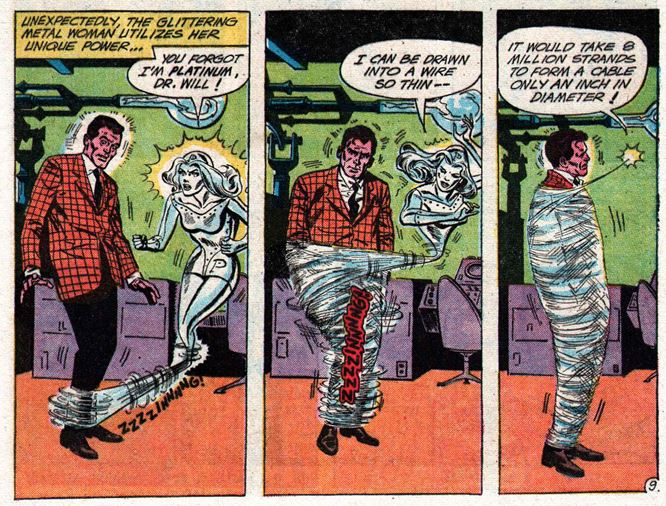
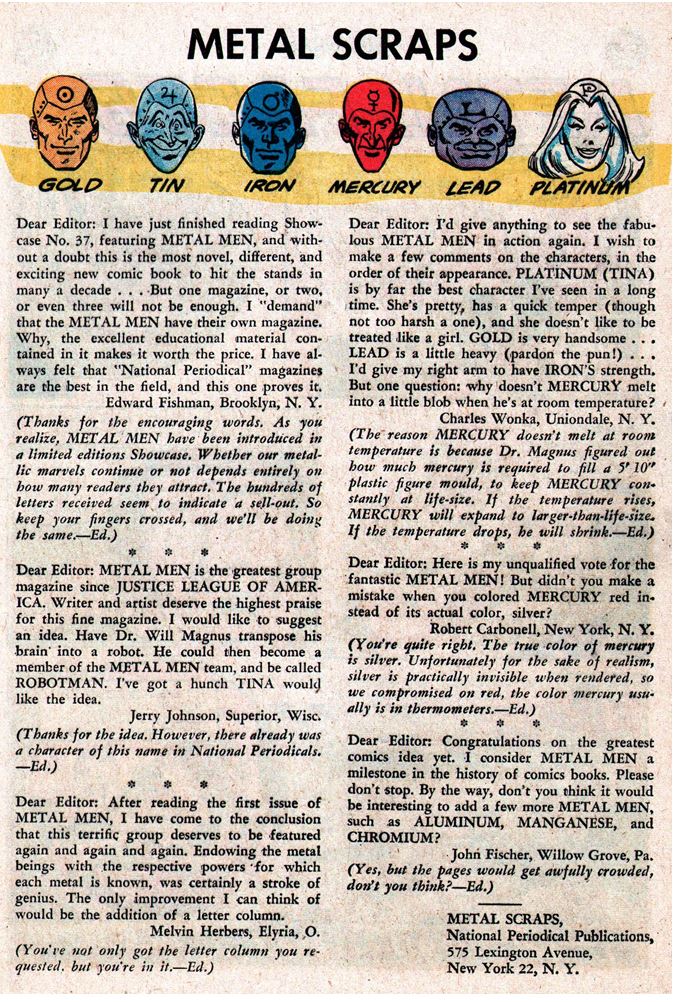
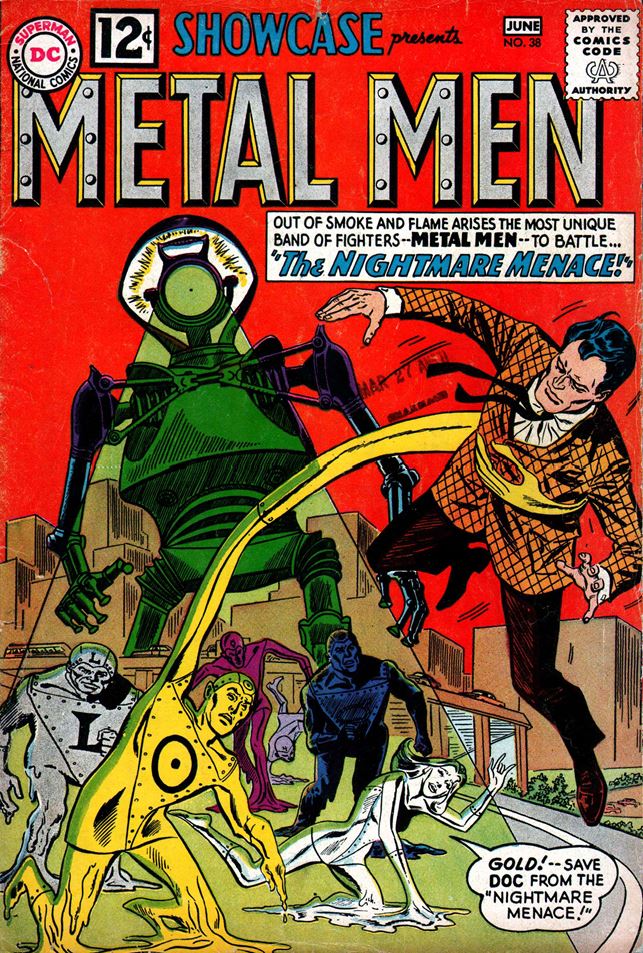
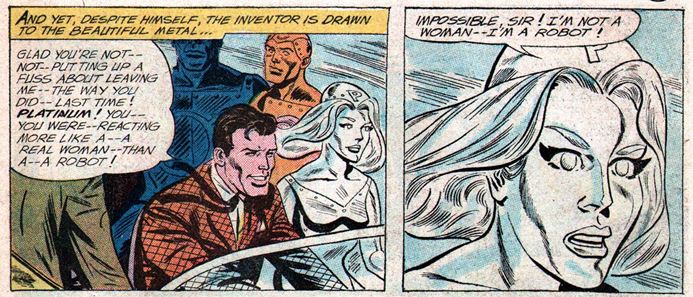
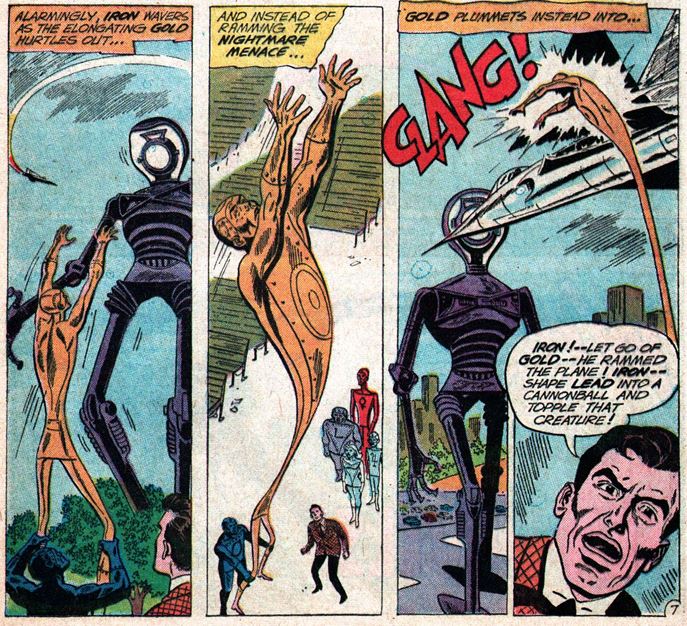
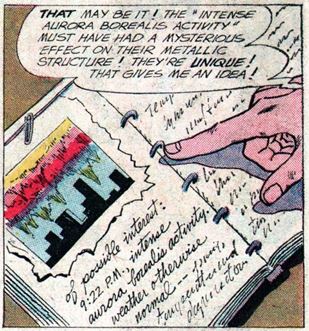
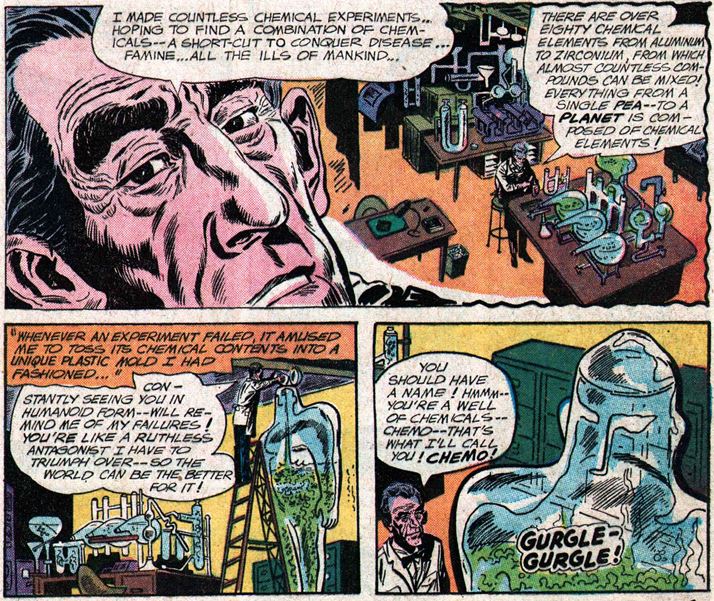
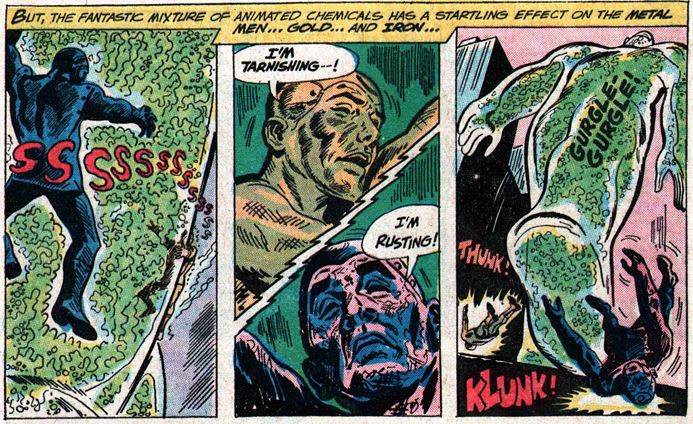
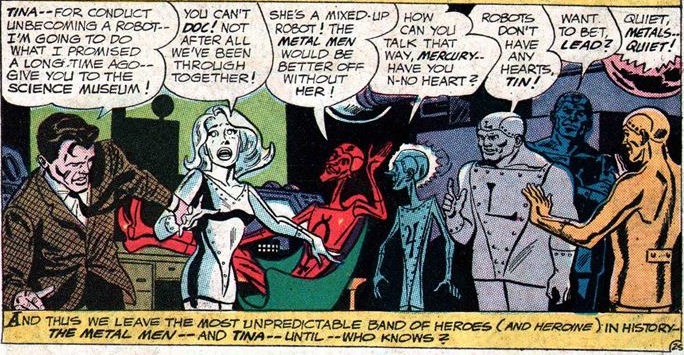
I LOVE the Metal Men! They are (along with other luminaries like Metamorpho and the Doom Patrol) what made DC in the 60’s a permanent beacon of culture for eight-year-olds everywhere.
[…] UNALLOYED PLEASURE. Steve Carper revisits a comic that fascinated me as kid in “Elementary, My Dear Metal Men” at Black […]